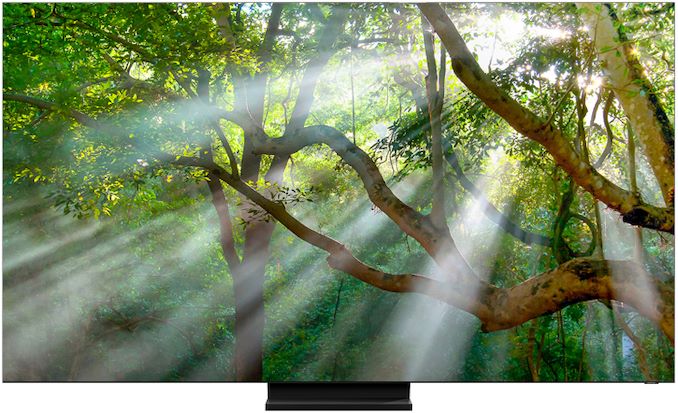CES 2020: Samsung’s 8K QLED TVs Use AI Quantum 8K SoC, Add Support For AV1 Video
by Anton Shilov on January 9, 2020 2:00 PM EST
Most years CES feels first and foremost like a TV show, and certainly this year's show hasn't disappointed. Among the many vendors making TV announcements for CES 2020 was Samsung, who introduced its upcoming lineup of premium 8K QLED televisions, the Q950-series. Samsung's new Ultra-HD TVs offer a 7680×4320 resolution with quantum dot enhancements, while under the hood Samsung is using its new "AI Quantum 8K" SoC that brings support for the cutting-edge AV1 codec as well as some additional capabilities.
One of the key features of Samsung’s Q950-series 8K televisions is the so-called ‘Infinity Screen’ design that uses extremely narrows bezel to produce a scree-to-body ratio of 99%. Samsung also went thin on depth, with a thickness of just 15 mm, making the TV look rather small for the big panel within.
Unfortunately, though not uncommon for CES TV announcements, Samsung is not disclosing much in the way of the general characteristics of the Q950-series televisions; so if nothing else, we'd expect them to be same or better than those of its predecessors, the Q900-series. Which, as a refresher, those TVs featured a quantum dot-enhanced LED backlight that is also capable of FALD-like operation – which Samsung calls Direct Full Array Elite technology – driving a peak brightness of 4000 nits (the maximum luminance at which HDR content is mastered these days). Furthermore, the Q900-series TVs were already hitting 100% of the DCI-P3 color gamut.
Moving on, another important element of the Samsung Q950 Ultra-HD TV family is that they incorporate the company’s latest "Quantum Processor 8K" SoC, which has higher compute and machine learning performance. Along with Samsung's latest generation upscaling technologies – all but required given the lack of 8K native content today – the SoC is also capable of AV1 decoding. This makes the Q950 among the first TVs to get AV1 decoding, and sets it up nicely to be ready for next-generation streaming options using the higher efficiency codec.
In addition to video-related enhancements, Samsung also improved the audio sub-system of the of its Q950-series TVs both in terms of hardware and in terms of software. On the hardware side of things, the TV has an integrated 5.1 audio subsystem. As for software, the televisions support such capabilities as Active Voice Amplifier that improves voice clarity based on ambient noises; Object Tracking Sound+ to enhance surround sound in response to movements on the screen, and Q-Symphony to align the work of built-in audio subsystem with Samsung’s soundbars. Last but not least, the Q950-series TVs also support various voice assistants, such as Amazon’s Alexa, Samsung’s Bixby, and Google’s Assistant.
Samsung’s Q950-series televisions will be available later this year.
Related Reading:
- Samsung’s 8K QLED TV 55-Inch: A More Affordable 8K Ultra-HD TV
- Samsung's 2019 QLED UHD TVs: 8K TVs Revamped, 4K TVs Get New Panel & Backlighting
- Samsung at CES 2019: 219-Inch and 75-Inch Micro LED Ultra-HD TVs Demonstrated
- Samsung Announces iTunes Movie & TV Show Support In Its 2018, 2019 Smart TVs
- Samsung Begins Sales of 65-Inch Q900R 8K UHDTV in the UK
- Samsung Starts to Take Pre-Orders on 85-Inch Q900 8K UHDTV
- Sharp to Demonstrate 120-Inch 8K LCD TV & 8K TV with 5G Modem at IFA
Source: Samsung











22 Comments
View All Comments
Amandtec - Thursday, January 9, 2020 - link
Glad they finally found a use for quantum computers.imaheadcase - Thursday, January 9, 2020 - link
I always wondered why TV didn't support certain video/audio codec? My LG OLED for example only plays AVI files..but the TV itself converts them into a certain type of file to only play on the TV. Obviously you can stream to it via a PC, but if you just use its storage, or plug in USB devices it converts stuff.I didn't think licencing mattered since most those are open now?
eddman - Thursday, January 9, 2020 - link
AV1 (one), not AVI (eye).Besides, AVI is a container not a codec, and an ancient one at that. I don't think any legal video is released in this format anymore; even pirates seem to have stopped.
imaheadcase - Friday, January 10, 2020 - link
I know that, but the question is still the same. AVI is still widely used in security cameras fyi.mooninite - Thursday, January 9, 2020 - link
This comment area is not the best method of learning, but I'll give you a few tips. I encourage you to Google for more information.1. AVI is not a codec. It is a container. You put video and audio files inside of an AVI container (file). It is also an old, now pathetic, container.
2. Licensing is *required* on all but 4 video codecs and all but 4 audio codecs.
The only free video codecs are MPEG-2, VP8, VP9, and AV1 (A-V-one). The only free audio codecs are MP3, Opus, Vorbis, and FLAC.
H.264, H.265, MPEG-4, AAC all require a license. When you purchase an iPhone or an Android device you may not realize it but Apple and Google (or the OEM partner) paid for your license.
We need non-free codecs to go away.
heffeque - Thursday, January 9, 2020 - link
Opus... if only everyone and everything used it... It's compression quality in the latest version (1.3.1) dances all around MP3 and Vorbis in all bitrates (high, medium, low and ultra-low) while having adaptive bitrates, using very little CPU and having an extremely low delay.Quality differences are easier to distinguish in ultra-low bitrates, were Opus manages to maintain wideband even at 9 Kbps (that's REALLY impressive), but low and medium bitrates also are pretty distinguishable from MP3 and Vorbis.
As for high bitrates of Opus, they are virtually indistinguishable from lossless codes such as FLAC at a portion of its size.
And now that it started to support ambisonics... hopefully it'll get more and more popular, so more brands will support it!
imaheadcase - Friday, January 10, 2020 - link
They how does VLC use all those codec when windows does not?mooninite - Friday, January 10, 2020 - link
VLC uses ffmpeg, which is an open source implementation of just about every codec that exists. The catch is that neither VLC or ffmpeg have paid for a license. If VLC or ffmpeg were to charge money or distribute binaries in the USA they would be sued. They get around it by hosting in countries that don't prosecute for license / patent violations on software.vladx - Friday, January 10, 2020 - link
They received a free license for all these codecs because it's a university-backed project.name99 - Friday, January 10, 2020 - link
But a TV is going to need a 265 license anyway if it supports ATSC3, no?So why not make that visible to streaming users if they want to utilize it? Is an ATSC3-limited license cheaper than a “general” license?